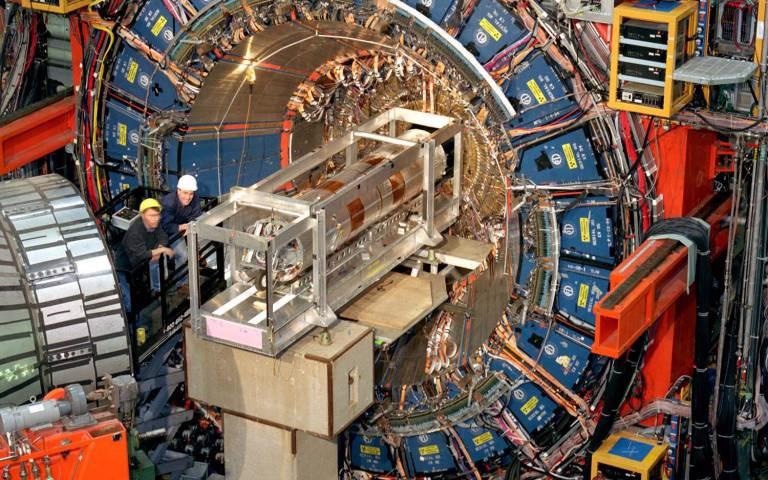Reviewed by Alex SmithApr 11 2022
The W boson, one of nature’s force-carrying particles, has been detected by the Collider Detector at Fermilab (CDF) team, which includes 400 scientists from across the world.
 The Collider Detector at Fermilab recorded high-energy particle collisions produced by the Tevatron collider from 1985 to 2011. About 400 scientists at 54 institutions in 23 countries are still working on the wealth of data collected by the experiment. Image Credit: Fermilab.
The Collider Detector at Fermilab recorded high-energy particle collisions produced by the Tevatron collider from 1985 to 2011. About 400 scientists at 54 institutions in 23 countries are still working on the wealth of data collected by the experiment. Image Credit: Fermilab.
The measurement does not match the value predicted by the Standard Model of particle physics, implying that the long-standing theory may require the inclusion of additional, as-yet-undiscovered, parts.
This new result from the CDF experiment, in which UCL was closely involved over many years, is potentially very exciting. The W boson is responsible for the weak nuclear force that mediates radioactive beta-decay and some of the nuclear processes taking place inside the Sun.
Professor David Waters, UCL High Energy Physics Group Leader and CDF Collaboration Member, Department of Physics & Astronomy, University College London
“By measuring very precisely how much the W boson weighs, we are testing Standard Model calculations that take into account quantum fluctuations involving heavy particles. This latest measurement is different to what is predicted, and adds to recent evidence from other experiments, such as those at Fermilab and CERN, that the Standard Model of particle physics may be missing some key elements - perhaps new particles or forces,” adds Professor Waters.
Professor Waters also stated, “The result needs to be scrutinized and confirmed. If this, and other, deviations from the Standard Model are indeed confirmed over the next few years, this would usher in a new era in particle physics.”
A decade of Careful Analysis
After ten years of painstaking investigation, the CDF collaboration at Fermi National Accelerator Laboratory (Fermilab) in the United States, announced the results.
Scientists have now established the particle’s mass with an accuracy of 0.01% using data collected by the cooperation, which is twice as exact as the previous best measurement.
This new mass measurement differs from what scientists would predict if researchers calculated mass using the Standard Model’s hypothesis.
The researcher’s analyzed data from the experiment’s run from 2003 to 2011 when it ceased collecting data. From 2000 to 2012, CDF was supported by the Science and Technology Facilities Council (STFC).
Results like this demonstrate the hidden effort of science—the years of careful number-crunching to progress closer to a new understanding. Physics beyond the Standard Model can come in careful iterations, edging us towards exciting new answers. STFC proudly continues to support UK scientists in the hunt for physics beyond the Standard Model in experiments including the Large Hadron Collider and others around the world.
Professor Grahame Blair, Executive Director, Program, Science and Technology Facilities Council, University College London
Although the new value agrees with some prior W boson mass measurements, there are significant discrepancies when compared to previous results, indicating that more measurements are required to confirm the finding.
Painstaking Work
The W boson is a weak nuclear force messenger particle that is involved in the nuclear processes that cause the sun to shine and radioactive particles to decay.
From 1985 to 2011, the CDF collaboration gathered massive volumes of data containing W bosons using high-energy particle collisions generated by Fermilab’s Tevatron collider.
For more than 30 years, CDF physicists have strived to improve the precision of W boson mass measurements. This finding is based on the whole dataset acquired from Fermilab’s Tevatron collider’s second run. It is based on the observation of 4.2 million W boson candidates, which is roughly four times the quantity utilized in the collaboration’s 2012 published analysis.
A total of 400 scientists from 54 institutions in 23 countries, including the United Kingdom, are part of the CDF partnership. It includes researchers from UCL as well as Glasgow, Liverpool, and Oxford universities.